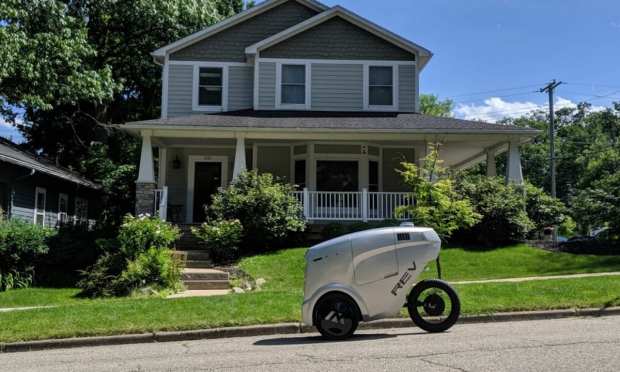Refraction’s Bike Messenger Robots Find ‘Goldilocks Zone’ Of Autonomous Delivery

As the past year has driven demand for affordable, convenient food delivery options to unprecedented levels, grocery leaders have been racing to come up with the most reliable and cost-effective options. Between Instacart’s recent $39 billion valuation, DoorDash’s introduction of on-demand grocery delivery, and funds pouring in at home and abroad for grocery and restaurant delivery solutions that promise to make the industry’s narrow margins work in their favor, it is becoming an increasingly competitive space. One company, robotics startup Refraction AI, which recently brought in $4.2 million in seed funding, may have found a solution — the REV-1 autonomous delivery robot, modeled after a traditional bike messenger.
“What’s different about [Refraction] is that, conventionally, last-mile delivery in this space happens using DoorDash or Grubhub or something like that,” Refraction’s CEO Luke Schneider told PYMNTS in a recent interview. “And it’s typically a gig economy worker driving a car, which is great and all, except it’s sort of like bringing a ballistic missile to a knife fight.”
He added that the cost of using cars and employing human drivers for every delivery “is actually pretty big,” explaining that “it’s not just the financial cost — it’s the cost of congestion, the cost of time and the cost of the quality of customer experience.”
Identifying The ‘Goldilocks Zone’
Refraction’s delivery robots, Schneider explained, are “really about the size of a bicycle — in fact, it’s based on a recumbent bike frame.” He added that unlike car deliveries, which can be dangerous and costly — and unlike sidewalk robots, which tend to be slow, not carry much and depend on contiguous sidewalks — Refraction’s robot, the REV-1, is “ideally sized to ride in the margins of the road.”
The robot was developed by two University of Michigan professors, a tenured robotics professor and an assistant professor in mechanical engineering. Its perception technology and its artificial intelligence (AI), Schneider said, enable it to navigate difficult weather conditions, and the robot is inexpensive to operate.
“By splitting the difference and coming up with this ‘Goldilocks zone’ idea, our founders said we could make a robot that’s big enough to carry a meaningful payload — we can carry like seven bags of groceries — and we can actually expand the range, because it can go a little bit faster,” he noted.
In addition, Schneider said, the bike-inspired model is more reliable in dense areas and is able to circumvent dense traffic to arrive within the expected timeframe: “Essentially, if we say we’re going to be there at noon, we’re there at noon.”
Growing In An Under-Penetrated Field
Schneider highlighted data from the United States Economic Research Service indicating that Americans spend about $1.8 trillion on food every year, pre-pandemic. “The penetration of delivery of any kind in that space is only about 5 percent, maybe 5 or 6 percent,” said Schneider. “A trillion and a half dollars … and that’s just the domestic market. And to see … middle single-digit penetration really indicates pent-up demand for the service.”
To grow to a point where it can access this pent-up demand, Refraction is focusing on three key points. The first, Schneider explained, is to prove the feasibility of the model. To do that, he said, “We need more reps, as they say.” Essentially, the company needs to add customers and fulfill more orders.
“The next thing that we need to demonstrate is scalability,” said Schneider, explaining that the company is looking to expand into new areas to show that REV-1 works in a wide variety of locations.
And the third thing is to build out the team, now that the company has the funds to bring in more employees.
Once the company has proven that the economics of its deliveries work, Schneider said, “it will unlock pent-up demand for delivery,” adding that the industry needs “a catalyst or some kind of a defining event” that leads to widespread adoption of “a reliable, affordable and ubiquitous way to deliver food or almost anything else.”
The Future Of Delivery
“Is delivery going to be a $100 billion market by 2026?” Schneider asked, rhetorically. “Probably not, but I think it’ll be well on its way. And I think 2030 is the year that all of us are looking at.”
Schneider explained that the path to this key milestone is “both technology-constrained and capacity-constrained.” Right now, the delivery options on the market do not collectively have the capacity to meet the widespread demand for the service. However, he projected, “if you could make improvements in vehicle design, autonomy and grid infrastructure to support it, at the same time investing in manufacturing capacity to build more delivery vehicles or delivery capacity,” then the delivery market would be on track to hit that 2030 target.
“Will delivery ever be 80 percent of all food now? Probably not,” he said. “But does it belong in the respectable double digits? Absolutely. And will we see a double-digit compound annual growth rate for it? No question, in my mind.”
